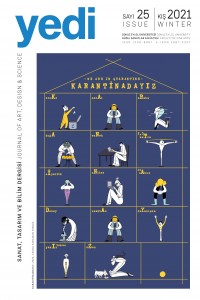Öz
Foucault’nun heterotopya kavramı heterojen kimliğiyle, birbiriyle bağdaşmaz unsurların yan yana, üst üste geldiği, ötekiliğin deneyimlendiği mevkileri yansıtır, postmodern dönemin hetorojenliğe ve ötekiliğe atfettiği özgürleştirici potansiyel ile bu kavram sanat alanında da sıkça karşımıza çıkmaktadır. Heterotopyalar, mekânsal yaşam alanına karışarak tecrit edebilir ve nüfuz edebilir niteliğiyle, kapatma ve kapanma pratiklerinde toplumsal bir karşılaşma imkânı sunarak ötekiliğe açılan geçitleri yaratır. Modern dönemde kapatma pratiklerinde tecrit, norm merkezli ayrıştırma sistemine dayanan, öznenin sabitlendiği panoptik bir disiplin biçimiyle yapılmıştır. Bu dönemde kapatma pratiklerinde panoptizm, yalnızca itaatkâr bedenler üretmemiş, aynı zamanda modern ruhu da tahakküm altına alarak kapanma pratiklerinin kabulünü kolaylaştırmıştır. Postmodern dönemin kaotik, heterojen kent imgesi içinde kapanma pratikleri, kamusal alana sızarak tahakküm mercii olmadan özgürlük fantazmagoryasıyla öznenin kendini sınırladığı bir mekanizmaya dönüşmüştür. Kapatma-kapanma pratikleri çağdaş sanata da yansıyarak, ötekiliğin özgürleştirici potansiyelinin gündelik karşılaşma formlarıyla sunulduğu deneyim alanlarını yaratmaktadır. Bu makalede, heterotopya alt başlığı altında incelenen kapatma-kapanma pratiklerinin tarihsel süreci irdelenerek, çağdaş sanattaki yansımalarını eserler üzerinden biçim-içerik analizleriyle ortaya koymak amaçlanmıştır.
Anahtar Kelimeler
Kaynakça
- Akay, A. (2016). Michel Foucault’da iktidar ve direnme odakları. Ankara: Doğubatı Yayınları.
- Baştürk, E. (2016). Gözetimin soykütüğü. İstanbul: Kalkedon Yayınları.
- Baudrillard, J. (2017). Simülakrlar ve simülasyon. (Oğuz Adanır, Çev.). Ankara: Doğu Batı Yayınları.
- Best, S. ve Kellner, D. (2016). Postmodern teori (Mehmet Küçük, Çev). İstanbul: Ayrıntı Yayınları.
- Deleuze, G. (2013). Foucault. İstanbul: Norgunk Yayıncılık.
- Doğan, İ. (2019). Hiçbir yerdeyiz [Enstalasyon]. Labirent Sanat, İstanbul. Erişim Adresi: https://static.wixstatic.com/media/ca3531_c2bf805482e54c97b84046e0da8c9451~mv2.jpg/v1/fill/w_1199,h_971,al_c/ca3531_c2bf805482e54c97b84046e0da8c9451~mv2.jpg
- Foucault, M. (2005). Özne ve iktidar seçme yazılar. İstanbul: Ayrıntı Yayınları.
- Foucault, M. (2015). Büyük kapatılma seçme yazılar 3. İstanbul: Ayrıntı Yayınları.
- Halley, P. (2019). Heterotopia I [Enstalasyon]. Galleria dell'Accademia. Venedik. Erişim Adresi: https://galeriasenda.com/en/peter-halley-presents-heterotopia-i-at-the-venice-biennale-2019/
- Han, B. C. (2020). Şeffaflık toplumu. (Haluk Barışcan, Çev.). İstanbul: Metis Yayıncılık.
- Harvey, D. (2010). Postmodernliğin durumu. (Sungur Savran, Çev.). İstanbul: Metis Yayınları.
- Munoz, J. (2001). Double bind [Enstalasyon]. Tate Modern, London. Erişim Adresi: https://www.metalocus.es/en/news/double-bind-juan-munoz-awakens-planta-after-a-long-dream
- Nakıboğlu, G. (2015). Ütopyadan doğmak, ütopya doğurmak: Heterotopya kavramı ve heterotopya bağlamında balık izlerinin sesi. FSM İlmî Araştırmalar İnsan ve Toplum Bilimleri Dergisi, 5, s. 381-408. doi: http://dx.doi.org/10.16947/fsmiad.47503
- Rifkin, J. ve Howard, T. (2001). Entropi: Dünyaya yeni bir bakış. İstanbul: İz Yayıncılık.
- Rebeyrolle, P. (1973-1985). Chien [Heykel]. L’Espace Paul Rebeyrolle, Eymoutiers. Erişim Adresi: https://cdn-s-www.leprogres.fr/images/1669F6E6-67A4-4203-B4D3-5E8CDE4A71A9/NW_raw/le-chien-1973-1985-bronze-prete-par-le-fond-permanent-de-l-espace-paul-rebeyrolle-d-eymoutiers-photo-yannis-drapier-1469460201.jpg
- Stavrides, S. (2018). Kentsel heterotopya. (Ali Karatay, Çev). İstanbul: Sel Yayıncılık.
- Şimşek, M. E. (2014). Moderniteden postmoderniteye uzanan bir köprü: Zygmunt Bauman (Yüksek Lisans Tezi). Atatürk Üniversitesi Sosyal Bilimler Enstitüsü, Erzurum.
- Tenger, H. (2020a). İçeri girmedik çünkü hep içerdeydik/dışarı çıkmadık çünkü hep dışardaydık [Enstalasyon]. Arter, İstanbul. Erişim Adresi: https://www.arter.org.tr/sergiler
- Tenger, H. (2020b). İçeri girmedik çünkü hep içerdeydik/dışarı çıkmadık çünkü hep dışardaydık [Enstalasyon]. Arter, İstanbul. Erişim Adresi: https://www.protocinema.org/img/exhibitions/hale-tenger/_exhibitionImage/IMGP04165.jpg
Öz
Foucault’s concept of heterotopia, with its heterogeneous identity, reflects the positions where incompatible elements are placed side by side, overlap each other and experience otherness. This concept is frequently encountered in the field of art with its liberating potential attributed to post-modernity hetogenicity and otherness. Heterotopias mingle with spatial habitats and, thanks to their nature of 'isolation and penetration', create passages that open to otherness by offering the possibility of a social encounter with inclusion and seclusion practices. In modern practice, isolation in occlusion was done in a panoptic discipline style based on the norm-centered decomposition system, where the subject is fixed. During this period, panopticism not only produced obedient bodies, but also facilitated the acceptance of seclusion practices by dominating the modern spirit. The closure practices within the chaotic, heterogeneous urban image of the postmodern era have become a mechanism in which the subject is self-limited by freedom fantasy without infiltration in the public space. The inclusion and seclusion practices are reflected in contemporary art, creating areas of experience where the emancipatory potential of otherness is presented in everyday encounter forms. This article aims to reveal the reflections in contemporary art through form-content analysis by examining the historical process of inclusion and seclusion practices examined under the subtitle of heterotopia.
Anahtar Kelimeler
Kaynakça
- Akay, A. (2016). Michel Foucault’da iktidar ve direnme odakları. Ankara: Doğubatı Yayınları.
- Baştürk, E. (2016). Gözetimin soykütüğü. İstanbul: Kalkedon Yayınları.
- Baudrillard, J. (2017). Simülakrlar ve simülasyon. (Oğuz Adanır, Çev.). Ankara: Doğu Batı Yayınları.
- Best, S. ve Kellner, D. (2016). Postmodern teori (Mehmet Küçük, Çev). İstanbul: Ayrıntı Yayınları.
- Deleuze, G. (2013). Foucault. İstanbul: Norgunk Yayıncılık.
- Doğan, İ. (2019). Hiçbir yerdeyiz [Enstalasyon]. Labirent Sanat, İstanbul. Erişim Adresi: https://static.wixstatic.com/media/ca3531_c2bf805482e54c97b84046e0da8c9451~mv2.jpg/v1/fill/w_1199,h_971,al_c/ca3531_c2bf805482e54c97b84046e0da8c9451~mv2.jpg
- Foucault, M. (2005). Özne ve iktidar seçme yazılar. İstanbul: Ayrıntı Yayınları.
- Foucault, M. (2015). Büyük kapatılma seçme yazılar 3. İstanbul: Ayrıntı Yayınları.
- Halley, P. (2019). Heterotopia I [Enstalasyon]. Galleria dell'Accademia. Venedik. Erişim Adresi: https://galeriasenda.com/en/peter-halley-presents-heterotopia-i-at-the-venice-biennale-2019/
- Han, B. C. (2020). Şeffaflık toplumu. (Haluk Barışcan, Çev.). İstanbul: Metis Yayıncılık.
- Harvey, D. (2010). Postmodernliğin durumu. (Sungur Savran, Çev.). İstanbul: Metis Yayınları.
- Munoz, J. (2001). Double bind [Enstalasyon]. Tate Modern, London. Erişim Adresi: https://www.metalocus.es/en/news/double-bind-juan-munoz-awakens-planta-after-a-long-dream
- Nakıboğlu, G. (2015). Ütopyadan doğmak, ütopya doğurmak: Heterotopya kavramı ve heterotopya bağlamında balık izlerinin sesi. FSM İlmî Araştırmalar İnsan ve Toplum Bilimleri Dergisi, 5, s. 381-408. doi: http://dx.doi.org/10.16947/fsmiad.47503
- Rifkin, J. ve Howard, T. (2001). Entropi: Dünyaya yeni bir bakış. İstanbul: İz Yayıncılık.
- Rebeyrolle, P. (1973-1985). Chien [Heykel]. L’Espace Paul Rebeyrolle, Eymoutiers. Erişim Adresi: https://cdn-s-www.leprogres.fr/images/1669F6E6-67A4-4203-B4D3-5E8CDE4A71A9/NW_raw/le-chien-1973-1985-bronze-prete-par-le-fond-permanent-de-l-espace-paul-rebeyrolle-d-eymoutiers-photo-yannis-drapier-1469460201.jpg
- Stavrides, S. (2018). Kentsel heterotopya. (Ali Karatay, Çev). İstanbul: Sel Yayıncılık.
- Şimşek, M. E. (2014). Moderniteden postmoderniteye uzanan bir köprü: Zygmunt Bauman (Yüksek Lisans Tezi). Atatürk Üniversitesi Sosyal Bilimler Enstitüsü, Erzurum.
- Tenger, H. (2020a). İçeri girmedik çünkü hep içerdeydik/dışarı çıkmadık çünkü hep dışardaydık [Enstalasyon]. Arter, İstanbul. Erişim Adresi: https://www.arter.org.tr/sergiler
- Tenger, H. (2020b). İçeri girmedik çünkü hep içerdeydik/dışarı çıkmadık çünkü hep dışardaydık [Enstalasyon]. Arter, İstanbul. Erişim Adresi: https://www.protocinema.org/img/exhibitions/hale-tenger/_exhibitionImage/IMGP04165.jpg
Ayrıntılar
| Birincil Dil | Türkçe |
|---|---|
| Bölüm | Derleme Makaleler |
| Yazarlar | |
| Yayımlanma Tarihi | 18 Ocak 2021 |
| Gönderilme Tarihi | 15 Temmuz 2020 |
| Kabul Tarihi | 13 Aralık 2020 |
| Yayımlandığı Sayı | Yıl 2021 Sayı: 25 |
This work is licensed under a Creative Commons Attribution 4.0 International License.


